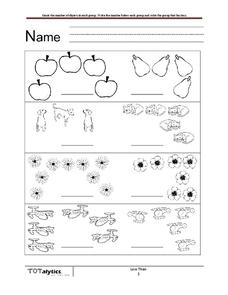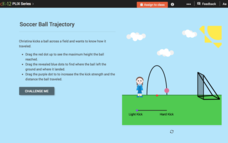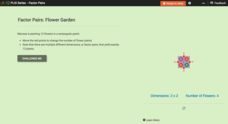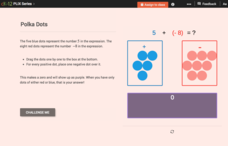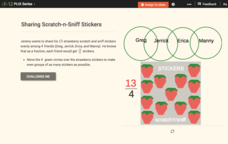Curated OER
Leopards: Spotting 10s
Count the spots on 4 pictured leopards and circle groups of 10. Count the extras. Write how many 10s and how many "left overs" in blank spaces. Write the total number in a box. Can a leopard change its spots? Enrich this math tool by...
Curated OER
Counting Objects
What an easy way to practice counting and comparing numbers! Learners examine four sets of drawings, each with two types of objects pictured. They count each object, writing the number below. Then, they color in the item with fewer...
Houghton Mifflin Harcourt
Unit 2 Math Vocabulary Cards (Grade 6)
Common denominator, invert, and terminating decimal are only a few terms found in a set of math vocabulary math cards. Made up of 40 cards, the set reinforces terms with boldly printed word cards, and definition cards offering an example...
K5 Learning
Addition and Subtraction Word Problems #1
Third graders read and solve six word problems and decide whether to add or subtract. The numbers range in 2-digit up to 4-digit.
CK-12 Foundation
Integer Division: Dropping Anchor
An interactive made up of five questions challenges mathematicians to divide integers and reflect on division properties. A moveable anchor aids in problem-solving. Question types include multiple-choice, true or false, and discussion.
Illustrative Mathematics
The Intersection of Two Lines
Here is an introduction to solving simultaneous linear equations. Start by drawing a line through two points. Create a second line which goes through the intersecting point. Background knowledge of how to find the equation of a line and...
K5 Learning
Addition and Subtraction Word Problems #2
Third graders read nine word problems and decide whether to add or subtract. The problems involve mostly 2-digit addition and subtraction.
Chicago Teachers Union Quest Center
Factored Form of a Quadratic Function
Build upon linear functions to learn about quadratics. The lesson introduces the concept of zeros for quadratic functions and makes the connection to the linear factors of the function. It presents quadratics in both graphical and...
CK-12 Foundation
Quadratic Functions and Their Graphs: Soccer Ball Trajectory
Determine critical points in the flight of a soccer ball. Pupils use an interactive resource to find the vertex and x-intercepts of the graph of the trajectory of a soccer ball after being kicked. Scholars investigate the trajectory...
CK-12 Foundation
Sums of Integers with Different Signs: Board Game
Five questions challenge scholars to show what they know about integers. Using an interactive board game, learners move pieces to discover where a player landed, then answer problems involving both positive and negative integers.
CK-12 Foundation
Common Multiples: Sports Calendar
Using a calendar, basketballs, and tennis balls, young mathematicians determine the common multiples of four and six. Individuals drag and drop the balls onto the correct dates each sport will be played, allowing them to see which days...
CK-12 Foundation
Factor Pairs: Flower Garden
Arrange the dimensions of Marissa's rectangular flower garden so that 12 flowers can be grown. How many factor pairs does the number 12 have? What dimensions are necessary for a square shaped planter?
CK-12 Foundation
Addition of Integers: Polka Dots
What happens when you add negative and positive integers to one another? Do you add or subtract, and will the answer be positive or negative? Young mathematicians use blue and red polka dots to determine the value of an expression that...
CK-12 Foundation
Equivalent Fractions: Number Line
Arrange improper fractions on a number line to determine the equivalency to whole numbers. The number line starts at -4 and ends at 4, while users must turn the improper fraction into a proper fraction in order to place it on the number...
CK-12 Foundation
Whole Number Addition: Let's Go Fishing!
Practice adding whole numbers by combining the amount of fish Alice and Bob catch. As young mathematicians work through each problem, they are asked to find one more plus the amount of fish already caught. They can manipulate the...
CK-12 Foundation
Improper Fractions as Mixed Numbers: Sharing Scratch-n-Sniff Stickers
No, you can't actually smell these 13 scratch-n-sniff stickers. But you can group them into equal groups of four, with one sticker remaining. Using that information, learners create a mixed number based on the improper fraction, 13/4.
CK-12 Foundation
Percent of a Number: Rock Climbing
What percent of the 100 ft. rock has Marta climbed? Young mathematicians find the percent of number (the rock height) by moving the climber up and down the rock.
CK-12 Foundation
Polynomials in Standard Form
Set the standard for working with polynomials. Pupils arrange two polynomial expressions in standard form. The scholars respond to questions about the terms, coefficients, and degrees of the polynomials. They then discuss how they can...
CK-12 Foundation
Addition of Polynomials: Splitting into Tiles
Count on tiles to add polynomials. Pupils drag virtual algebra tiles onto colored mats to represent the sum of two polynomials. The learners count the number of like tiles to find the coefficient of each term. They finish by discussing...
CK-12 Foundation
Mutually Exclusive Events: Lemon Roulette!
You first! An interactive sets up a game between two friends who hope they don't find a lemon hidden under a tray. Pupils determine whether there is an advantage of going first. Individuals find the probabilities of each friend finding...
CK-12 Foundation
Mutually Inclusive Events: Card Game
Find probabilities of pulling cards. Using a Venn diagram, individuals sort five cards along the rules of a game. The pupils calculate compound probabilities using the information from the diagram. Initially, the interactive provides the...
CK-12 Foundation
Definition of Probability: It's in the Bag!
It's not in the bag. An interactive provides the probability of picking a certain color marble from a bag after several marbles have been removed. Young mathematicians learn about dependent events from this resource.
CK-12 Foundation
Introduction to Mean, Median, and Mode: The Tree Conundrum
How many trees should we plant? Using an interactive as a manipulative, individuals find the mean, median, and mode for sets of data. They determine the number of trees to plant in each plot of land to reach a statistical goal.
CK-12 Foundation
Mode: Kittens
It is not as difficult as herding cats. The short interactive provides a group of kittens to sort according to their colors. Pupils determine the mode of the number of kittens by color. The questions continue with other numbers of...
Other popular searches
- No More Dead Dogs
- More or Less
- 10 More 10 Less
- More and Less
- How Many More on a Graph
- How Many More
- More Less Equally Likely
- Chateau De Mores
- I Will Fight No More Forever
- More or Fewer
- More Time Less Time
- More and Fewer



